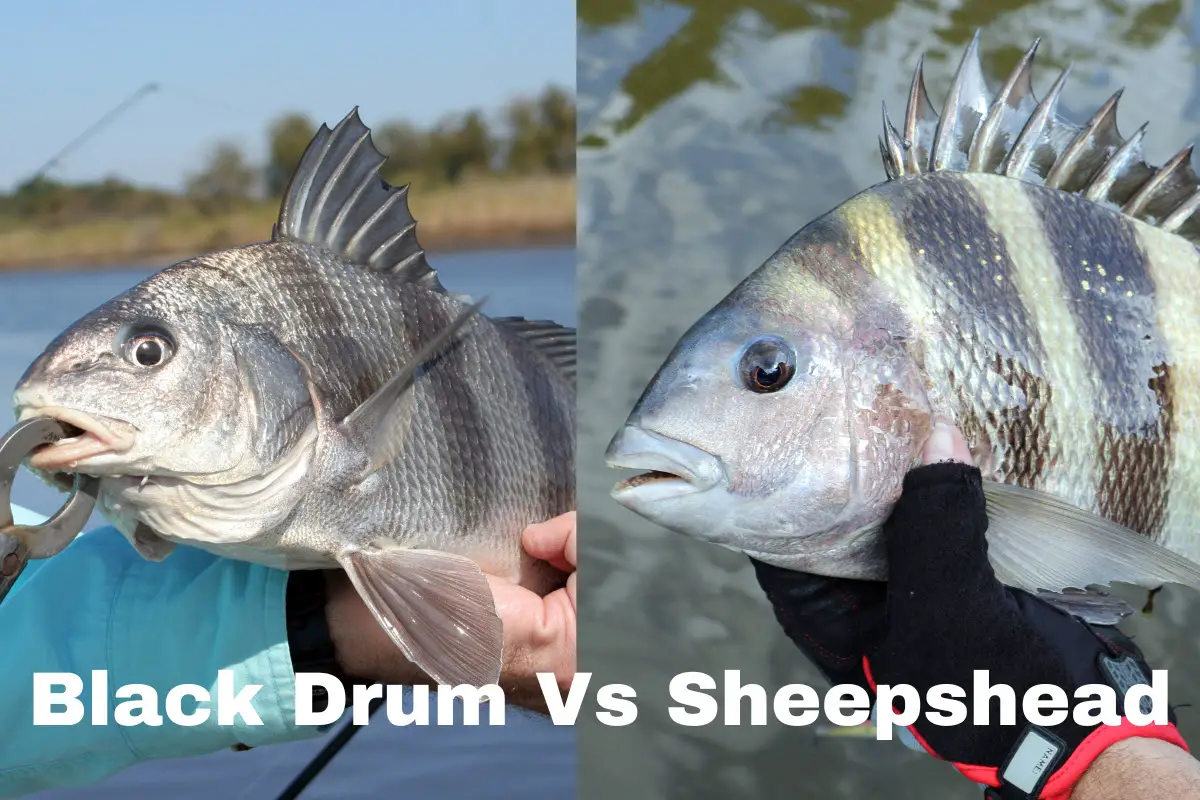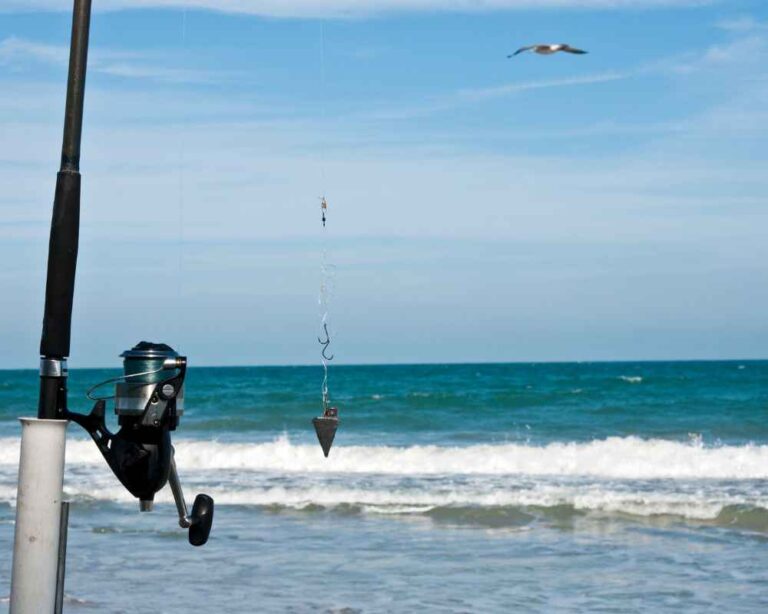Black Drum vs Sheepshead: Top Ways These Popular Fish Differ
Estimated reading time: 10 minutes
When it comes to coastal fishing in the eastern United States, Black Drum and Sheepshead are two fish species that always catch my attention. It’s important to understand the distinctions between these two species to make the most of your fishing trip. In this article, we’ll dive into the drum vs Sheepshead debate, offering valuable insights to help you decide which fish to target on your upcoming adventure.
So, whether you’re seeking the excitement of reeling in Black Drum or the thrill of hooking Sheepshead, let’s explore the differences between these popular fish species.
Physical Characteristics
Size And Weight
When it comes to comparing black drum and sheepshead fish, there’s a noticeable difference in size. While sheepshead typically stay under 15 pounds, black drum can reach much larger weights.
In fact, some black drum can weigh an impressive 90 pounds! On average, when fully grown, they weigh between 30 to 40 pounds. It’s fascinating to see how these fish can vary in size on my fishing trips.
Body Shape And Coloration
When it comes to the black drum and sheepshead, their body shape is a key characteristic that sets them apart within the drum family, which also includes the red drum.
What makes the sheepshead distinct is their unique teeth and rounded body shape, which differentiates them from the black drum. Their head is short and stout, while their back sits at a higher level. On the other hand, black drum have a more elongated body shape with a sloping forehead and a downward-facing mouth that they use to suck up prey from the ocean floor.
Their dorsal fins also showcase a difference – sheepshead have a more prominent and spiny dorsal fin that spans the entire length of their body, while black drum possess a dorsal fin that is less prominent and spiny.
Coloration is another distinguishing factor. Young black drum exhibit stylish dark stripes that gradually fade to a less flashy grey tone as they mature between 12 to 24 inches in length. As they age further, their coloration becomes more muted, featuring shades of grey, brown, or black. On the contrary, sheepshead display a grey or yellow body with seven distinct and well-defined black stripes along both sides.
Presence And Number Of Stripes
When it comes to telling the difference between black drum and sheepshead, their physical appearances are the key factors.
One noticeable distinction is that sheepshead fish have seven clear and defined vertical black lines on both sides of their body. On the other hand, black drum have vertical black stripes that are more noticeable when they are young but tend to fade as they grow older.
By paying attention to these characteristics, it becomes easier to identify and distinguish between these two fish species.
Geographical Range
Sheepshead fish are found in the western Atlantic Ocean, from Nova Scotia to Brazil. They are also found in the Gulf of Mexico, particularly in the northern and western parts. On the other hand, black drum fish are found in the eastern part of the Atlantic Ocean, from Massachusetts to Florida, and in the Gulf of Mexico from Florida to Texas.
Preferred Habitats
Let’s dive into the preferred habitats of two fascinating fish species: sheepshead and black drum. Sheepshead are frequently spotted in shallower waters, particularly around oyster beds, seagrass beds, and the tangled roots of mangroves. Meanwhile, black drum prefer deeper waters near channels, drop-offs, and the diverse coastal regions where salinity levels vary.
When it comes to finding these fish, keep an eye out for sheepshead near structures like docks, bridges, and piers along the coast. On the other hand, black drum tend to inhabit saltwater environments such as bays, sounds, and inlets. Their adaptability to different water temperatures and distinct habitat preferences make them captivating targets for anglers seeking excitement on their fishing trips.
Migration Patterns
You can find black drum and sheepshead in various habitats like saltwater coastal areas, freshwater bodies, and brackish waters. Black drum are present along the eastern United States, stretching from New England down to South Carolina, while sheepshead are commonly found in the coastal regions of South Carolina and Georgia. Interestingly, black drum can also be found in South America.
Understanding the migration patterns of these fish can greatly enhance your fishing success. During the winter, sheepshead tend to move to deeper waters, seeking warmth and shelter. On the other hand, black drum may migrate to warmer areas to escape the cold. Additionally, sheepshead may change their location in search of food, while black drum may travel to specific regions for spawning purposes. By staying informed about these patterns, you can increase your chances of a rewarding fishing trip.
Diet and Feeding Habits
You know, black drum and sheepshead are two fish that you often catch when you’re fishing near the bottom. They both love to munch on crustaceans like shrimp, crabs, and oysters. But, interestingly enough, they do have some differences when it comes to what they eat and how they feed.
Diet And Preferred Prey
Black Drum are opportunistic feeders and eat almost anything they can find on the bottom of the water. They prefer to feed on crustaceans, such as crabs and shrimp, but will also eat small fish and mollusks. According to Cast and Spear, black drum can even eat small stingrays and catfish.
On the other hand, sheepshead are omnivores and like feeding on small vertebrates, insects, and plant products. They have a unique set of teeth that are highly defined, including incisors, molars, and grinders. They use these sharp teeth to crush the shells of their prey, such as barnacles, clams, and oysters. Large juveniles and adults prey on blue crab, crustaceans, and small fish, including young Atlantic croakers.
Feeding Behavior And Techniques
Black drum are bottom feeders that use their sense of smell to locate prey on the ocean floor. They primarily feed during the day and use their chin barbel to taste and pinpoint the exact location of their food. Anglers can use live or cut bait, such as shrimp or crab, to attract and catch black drum.
Sheepshead, on the other hand, are also bottom feeders, and their diet primarily consists of crustaceans found in oyster reefs and brackish waters. They have a mouthful of teeth that allow them to eat bait cleanly off the hook, making it challenging to catch. Anglers need to be patient and wait for the fish to take the bait fully before setting the hook. Sheepshead prefer to feed during the day, particularly in shallow coastal waters near oyster beds, as well as in deep and turbid waters. They can also feed at night.
Fishing Techniques
Best Methods For Catching Each Species
When targeting black drum, anglers should use a bottom fishing technique. A Carolina or fish finder rig is the perfect rig to catch them. These rigs allow the bait to sit on the ocean floor where black drum typically feed, and anglers can detect fish strikes by watching the rod tip.
Sheepshead, on the other hand, are often found near structures such as docks, pilings, and artificial reefs, making fishing around these areas the best way to catch them. Both species can be caught using artificial lures like jigs and soft plastics, but live or cut bait is often more effective.
Recommended Bait And Tackle
To catch black drum, most anglers use fresh dead or live shrimp, crab, or cut bait. Sheepshead, on the other hand, prefer fiddler crabs, sand fleas, and barnacles as bait.
When it comes to tackle, a medium-heavy rod and reel combo with a 20-30 pound line is recommended for both species. Anglers should have their reels spooled with a braided fishing line and attach a fluorocarbon leader.
For black drum, a fish finder rig with a 2-3 ounce weight is recommended. For sheepshead, a light jig head or split shot rig will suffice. The size rod used depends on the size of the fish being targeted, with larger fish requiring a heavier rod.
Techniques For Targeting Specific Fish Sizes
When targeting larger Black Drum, it’s important to use heavier tackle and larger baits, such as whole blue crabs or large chunks of cut bait.
Sheepshead, on the other hand, tend to prefer smaller baits, so downsizing your bait and tackle can be effective in targeting smaller fish.
Additionally, when fishing for sheepshead, it’s important to pay attention to the tide and target areas where the current is moving, as this is where they are most likely to feed.
Culinary Uses
Flavor And Texture Of The Fillets
Black drum and sheepshead both have firm, white flesh that is mildly sweet and flaky. However, there are some differences in their flavor and texture.
Sheepshead fillets have a delicate, sweet flavor with a slightly firmer texture than Black Drum fillets. Black Drum fillets have a slightly stronger flavor with a firmer texture that is more suited to grilling or blackening.
Recommended Cooking Methods
Both Black Drum and sheepshead can be cooked in a variety of ways, including grilling, baking, frying, and broiling. However, they are best suited to grilling or blackening because of their firm texture. Sheepshead is also well-suited for baking or broiling. Both fish are also excellent when fried, with a crispy outer layer and tender, flaky flesh inside.
Culinary Applications And Recipes
Black drum and sheepshead are versatile fish that can be used in a variety of culinary applications. They are excellent in fish tacos, ceviche, chowders, and stews. They are also delicious when served with a variety of sauces, such as garlic butter, lemon butter, or tartar sauce.
One popular recipe for Black Drum is a Blackened Black Drum. To make this dish, the fillets are coated in a spice rub and then seared in a hot skillet until blackened on the outside and cooked through on the inside.
Another popular recipe for sheepshead is baked sheepshead with lemon and garlic. To make this dish, the fillets are seasoned with lemon and garlic and baked in the oven until tender and flaky.
Overall, black drum and sheepshead are both excellent choices for seafood lovers. Their firm, white flesh, and mild, sweet flavor can be used in various culinary applications and prepared in various ways.
Other Sources
The following web pages were used as sources for this article on Black Drum vs Sheepshead:
Frequently Asked Questions
Here are some of the most frequently asked questions about black drum and sheepshead:
What is the difference between Black Drum and Sheepshead?
Black drum and sheepshead are distinct saltwater fish. Sheepshead have a sleek body and 5-6 vertical bars on their sides, while Black Drum are bulkier with 3-4 bars. Sheepshead also have smaller mouths than Black Drum.
What do Black Drum and Sheepshead eat?
Both black drum and sheepshead are bottom feeders. They eat a variety of things, such as crabs, shrimp, and small fish. However, sheepshead have a preference for crustaceans and mollusks, while black drum eat more benthic invertebrates and small fish.
What is the average size of Black Drum and Sheepshead?
Sheepshead typically grow to be about 15 pounds, while Black Drum can grow much larger and heavier. The average size for a Black Drum is roughly 40 to 60 inches,. They often weigh about 50 to 80 pounds.
Where can you find Black Drum and Sheepshead?
Black drum and sheepshead are saltwater fish commonly found in coastal waters. Expect to find these two fish species around marshy areas and along dock pilings.
Conclusion
Black drum and sheepshead are two popular game fish found in coastal areas but differ in many ways.
Sheepshead’s slender body has vertical bars, while Black Drum’s body is robust with dark coloration. Sheepshead primarily feed on crustaceans, while Black Drum have a varied diet.
Fishing for these species requires different techniques and equipment. Sheepshead are caught using live bait or lures, while Black Drum are caught using cut bait or crab.






